Maximizing Style and Function in Studio Apartments
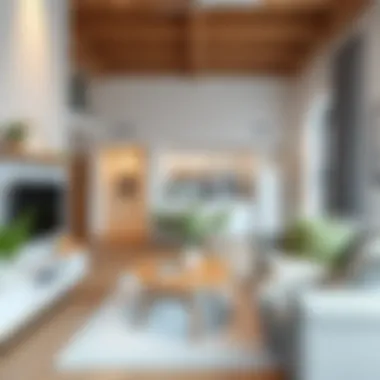
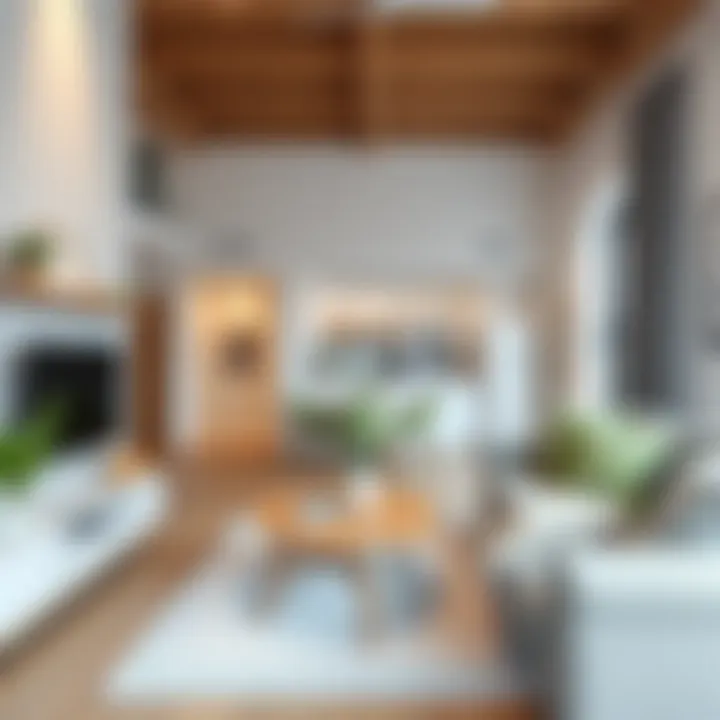
Intro
As urban living continues to evolve, one room studio apartments have gained notable traction. They combine functionality with a dash of style, catering to a growing demographic of city dwellers seeking comfort in compact spaces. But what exactly makes these micro-homes so appealing? Through this article, we will journey into the complexities of these spaces, unraveling their design secrets, practicality, and the charm that makes them increasingly popular in modern life.
You might find yourself wondering how one can successfully transform a limited area into a lively and inviting home. This discussion will shed light on various aspects, from understanding their architectural features to exploring interior design inspirations that can elevate a studio from basic to beautiful.
Home Features
Architectural Marvels
One room studio apartments are often masterpieces of architectural ingenuity. These compact dwelling units utilize every square inch efficiently, often featuring open floor plans that eliminate unnecessary walls. Think of it as merging the best of a living room, bedroom, and sometimes even a kitchen into one harmonious space.
The versatility of studio apartments can be attributed to several key architectural elements:
- Open Layouts: A hallmark feature allows for a seamless flow between different functional areas. The absence of constricting walls can make a small space feel expansive.
- Multipurpose Features: Many studios incorporate built-in furniture or multifunctional fixtures where one piece serves various roles. For instance, a Murphy bed can fold up against the wall, creating more room during the daytime.
- Natural Light: Large windows or glass doors not only brighten up the studio but also create an illusion of more space by connecting the indoors with the outdoors.
Unique Design Elements
The design aspect of a studio apartment plays a pivotal role in maximizing comfort and style.
- Zoning: Smart zoning techniques can help in delineating different areas within the same room without a physical divide. Rugs can be an excellent way to visually separate the sleeping area from a living space.
- Vertical Space Utilization: Utilizing wall space for shelving or hanging storage can keep the floor area clear, resulting in a more open feel.
- Statement Pieces: Incorporating bold art or a striking piece of furniture can draw the eye and distract from the size of the space. Creating focal points adds character and depth.
"A well-designed studio can whisper elegance while shouting comfort—every inch counts."
By embracing these architectural highlights and thoughtful design elements, one can unlock the full potential of a studio apartment, leading to a productive and stylish living space.
Interior Design Inspirations
Color Palettes and Themes
In a one room studio, color plays a significant role in defining the ambiance. You’ll want to select hues that support spaciousness and light—consider using soft neutrals or pastel shades that can open up the room. Accents of deep colors can be strategically applied to create depth without overwhelming.
Some popular palettes include:
- Soft Whites and Light Grays: These shades can evoke a tranquil atmosphere, making even the smallest space feel serene.
- Earthy Tones: Bringing the outside in with greens, browns, and sandy colors fosters a cozy, natural vibe.
- Accent Colors: Vibrant splashes of color, such as mustard yellow or navy blue, can create joyous focal points without taking over.
Furniture Arrangement Tips
In the realm of furniture placement, it’s critical to opt for pieces that don’t just fill a space but enhance its usability. Pay attention to:
- Scale and Proportion: Avoid oversized furniture; instead, go for streamlined options that belong in a smaller footprint.
- Flow: Arrange your furniture to promote circulation throughout the apartment. Walkways should be clear, allowing for easy movement.
- Functional Arrangements: Create zones by grouping furniture in a way that defines living, sleeping, and working areas but still keeps the overall space feeling cohesive.
By thoughtfully implementing these design strategies, one can achieve a style that is both functional and aesthetically pleasing, transforming any studio into a welcoming sanctuary.
Intro to One Room Studio Apartments
The concept of one room studio apartments has transitioned from basic necessity to sought-after living spaces, especially in urban environments. These compact designs encapsulate adaptability, where every square foot is precious. Understanding the intricacies of these apartments goes beyond mere floor plans; it dives deep into the lifestyle that accompanies such living arrangements.
Living in a studio leads to a unique blend of challenges and benefits, from how space is utilized to the way personal style can manifest within limited boundaries. Often characterized by an open floor plan that combines living, dining, and sleeping areas, these studios present an opportunity for creative design solutions that can make a small area feel expansive and functional.
A significant benefit lies in the simplified lifestyle that accompanies these apartments. With fewer rooms to manage, residents often find it easier to maintain cleanliness and order. This is particularly appealing for individuals who value minimalism. Of course, there are trade-offs to consider; privacy and space for guests can be challenging in a studio layout. But in the right hands, these limitations can be transformed into opportunities for innovative design.
In this article, we will explore the essence of one room studio apartments. We will delve into their characteristics and the reasons behind their rising popularity, alongside practical tips for making the most of these compact living situations.
Designing Your Studio Apartment
Designing a studio apartment can feel like piecing together a puzzle. Each segment must fit together like the perfect jigsaw, creating a space that doesn’t just serve but also inspires. The importance of this topic in the context of one-room living cannot be overstated. When one thinks about studio apartments, the challenge often lies in the balance between functionality and aesthetics. With everything packed into that single room, strategizing the design is essential. A well-thought-out apartment can transform a small space from cramped to cozy, making even the tiniest abode feel like a sanctuary.
Space Planning Basics
Space planning in a studio apartment serves as the blueprint for how that limited square footage functions. Think about it: without proper layout, one room can quickly become a chaotic free-for-all. Planning begins with understanding what activities you want your space to accommodate. Do you need an area for working? Relaxing? Entertaining? Identifying these zones helps in maximizing every square inch.
Start by measuring all dimensions and keep the layout flexible. Consider open spaces where light flows, and avoid overcrowding with oversized furniture. A simple sketch or even using design apps can help visualize the layout before heavy lifting begins.
Zoning Techniques
Zoning plays a crucial role in creating distinct areas in a studio apartment. This concept allows for division without physical barriers, thus maintaining open space while providing a sense of separateness.
Creating Distinct Areas for Living
Creating distinct areas for living enhances both functionality and style. By delineating spaces with furniture, rugs, or color schemes, one can establish a sleeping nook away from the living area. This not only provides purpose but also lends a psychological boundary that enhances livability. Rooms that feel like rooms, even when they aren't, tend to alleviate the feeling of being confined.
A key characteristic of this approach is the synergy it creates; each zone complements the others while maintaining an individual flair. Consider a bookshelf that acts as a room separator or a strategically placed plant stand that visually separates the dining area from the workspace. These features convert the room into an engaging space with a personality, making it a better choice for those seeking clarity in their living arrangement.
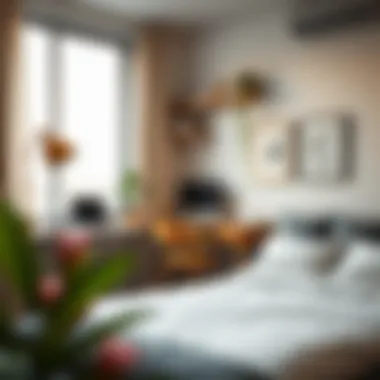
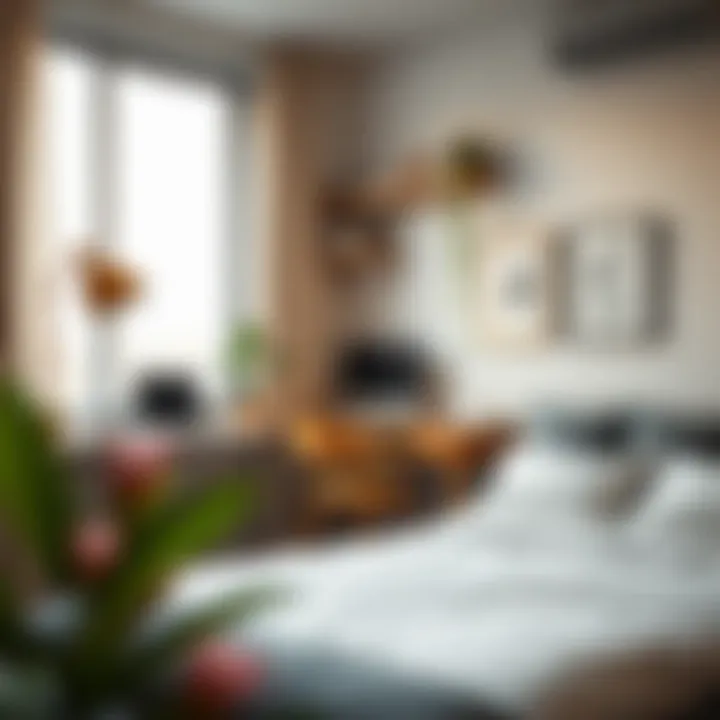
"Effective space management is about solving problems, not just fitting furniture in a room."
Separation Without Walls
Another innovative zoning technique is separation without walls. This method embraces the concept of open living but introduces ideas like room dividers, curtains, or furniture arrays that create an illusion of walls without the confinement.
This technique is particularly advantageous for those who want to maintain a sense of openness without sacrificing privacy. Strategically placed screens or a hanging curtain can provide the solitude of a bedroom without hampering the flow of the living area. The versatility of this approach lies in the ease by which one can adapt and change the space as needs evolve.
Choosing the Right Furniture
The furniture you select significantly impacts how the space functions. In studio apartments, the right choice balances style and utility, seamlessly integrating both into a compact area.
Multi-functional Pieces
Multi-functional pieces are a cornerstone of smart design in small living spaces. Consider a sofa that transforms into a bed or a coffee table that converts into a dining table. Not only do these items save space, but they also enhance adaptability in your home. They cater to various uses without cluttering the room with excess furniture.
Their key characteristic is versatility. They can morph and adapt based on your daily needs while adding style to your home. It’s no wonder they are a popular choice for studio dwellers who value both aesthetics and practicality. However, selecting quality over quantity is crucial; a cheap pull-out bed may cause more hassle than it’s worth over time.
Scale and Proportion
Scale and proportion speak to how objects fit within a given space. Choosing appropriately sized furniture ensures the apartment doesn’t feel overstuffed or unfinished. A giant sectional sofa might dominate the room and distort its dimensions, making it feel smaller than it is. Conversely, too-small items can feel lost and fail to provide utility.
A hallmark of good design here is to create harmony. Selecting pieces that reflect the room’s scale creates an inviting atmosphere. However, always remember, a well-proportioned apartment doesn’t mean everything has to match. Instead, it’s about achieving a visual rhythm that calms the eye and enhances the living experience.
Maximizing Storage in Limited Spaces
When living in a studio apartment, space is often at a premium. Maximizing storage is not just a matter of convenience; it’s essential for achieving a livable and organized environment. The compact nature of studio living can easily lead to clutter, making it crucial to devise clever storage solutions. By employing smart storage strategies, residents can transform their limited space into a functional sanctuary. Understanding the significance of effective storage techniques can greatly improve comfort and enhance the overall lifestyle experience in a studio apartment.
Underutilized Spaces
Utilizing Vertical Space
One of the most overlooked aspects of storage optimization is utilizing vertical space. Walls can serve as the silent workhorses of your small home, storing everything from books to decorative items. By taking advantage of height, one can effectively maximize limited surface area.
The key characteristic of using vertical space lies in its ability to draw the eye upward, creating an illusion of a larger room. It’s a popular choice because it doesn’t require significant structural changes and can be adapted to various decor styles.
Unique features like wall-mounted shelves or tall bookshelves can store an impressive amount of items while keeping the floor clear. One significant advantage of this method is the accessibility for items used regularly. However, the disadvantage could be the challenge of reaching high spaces without a stool, especially for shorter individuals. Yet, for those willing to climb a bit, the space benefits are clearly rewarding.
Furniture with Built-in Storage
Another excellent strategy involves furniture with built-in storage. This concept taps into the dual functionality of furniture pieces, allowing them to serve multiple purposes. Think about how a bed with drawers underneath can hide linens or a coffee table that opens up for extra storage.
The key trait of built-in storage is practicality. In a studio, every inch counts, and this approach embodies efficiency by integrating storage into essential furniture. It not only declutters but also preserves the aesthetic appeal of the living space.
A unique feature of such furniture is its ability to maintain an organized look while subtly hiding away the clutter of daily life. The advantages include maximizing space and keeping items easily accessible, while a potential downside might be the initial cost or the limited options available in style. However, the investment tends to pay off in the long run by enhancing the functionality of your studio.
Decluttering Strategies
Decluttering is a powerful strategy to maximize storage in any limited space. It’s not merely about discarding items; it’s about being intentional with what you keep. Regularly assessing belongings can prevent stacks of unused items from accumulating, making way for a cleaner, more functional environment.
Establishing a routine—like going through belongings every few months—ensures that what’s in your apartment is needed and used. Another effective method is the one-in-one-out rule, where for every new item brought in, an old one must be let go. This helps control the number of possessions and maintain an organized space.
Color Schemes and Lighting
Color choices and lighting are crucial elements in maximizing the appeal and functionality of studio apartments. A thoughtfully selected color scheme can open up a room, giving the illusion of larger space while setting the mood. Lighting, on the other hand, brings colors to life and enhances the overall design aesthetic. Each serves not only to beautify but also to optimize the living experience within limited confines.
Choosing Colors for Small Rooms
Light vs. Dark Colors
When it comes to choosing colors for small spaces, there’s a notable debate between light and dark hues. Light colors, such as whites and pastels, tend to reflect natural and artificial light, creating an airy feel. They act as visual lightweights, which is exactly what you need when the space is tight. On the flip side, dark colors can add depth and richness, producing a dramatic effect that draws the eye.
- Key Characteristics: Light colors broaden the perceived space, making it feel more open. Dark colors bring a cozy, intimate vibe.
For instance, if your studio apartment has a single window, painting it in soft gray or a creamy white can make the most of the light that comes in. But if you have a vibrant personality and want to express it, a deep navy or charcoal can work wonders, especially when accented well.
- Advantages: Light colors help to electronize and enlarge smaller areas, while dark colors create warmth and style.
- Disadvantages: However, too much darkness can make a room feel cramped if not balanced correctly.
Accent Walls Considerations
Accent walls are a game-changer in the art of studio decor. They allow you to introduce bold colors or patterns without overwhelming the space. By highlighting only a single wall, you could create a focal point that becomes the conversation starter of the room.
- Key Characteristic: An accent wall provides contrast, breaking the monotony that might come from uniform color schemes.
In a small studio, a bright yellow or a patterned wallpaper against a more neutral backdrop can make a striking impact. Moreover, using textured paint or wallpaper can add even more depth, giving the wall an interesting twist.


- Unique Feature: They serve to personalize the space without requiring a full renovation.
- Advantages/Disadvantages: While they can elevate style, improper execution may make the room feel disjointed or chaotic if colors clash or if the wall doesn't suit the rest of the decor.
Lighting Solutions
Effective lighting extends far beyond a single bulb hanging from the ceiling. It can manipulate the ambiance and functionality of a studio apartment. A well-lit space feels inviting, while shadows can either create a cozy nook or highlight clutter.
Natural Light Optimization
Maximizing natural light should be at the forefront of any design strategy, especially in small studio apartments. Natural light not only brightens the room but also enhances the colors of your interior.
- Key Characteristic: Natural light is a free resource that energizes your space without costing a dime.
To optimize it, consider window treatments that both regulate daylight and privacy. Sheer curtains, for instance, allow sunlight to filter in while still preserving a sense of enclosure. Mirrors can also bounce light around the room, amplifying the effect.
- Advantages: Creating a well-lit room can help lift spirits and improve overall well-being.
- Disadvantages: On the downside, too much direct sunlight can fade fabrics and furniture over time if not managed properly.
Layered Lighting Techniques
Layered lighting is all about adding dimension and functionality to your space. By integrating different sources of light—ambient, task, and accent—you can craft a versatile environment capable of changing its mood based on the time of day and activity.
- Key Characteristic: Layered lighting provides flexibility, allowing the space to serve various functions, from studying to entertaining.
For example, pendant lights above a dining area complemented by floor lamps near the couch can create a warm atmosphere perfect for both eating and relaxing.
- Unique Feature: This technique allows studio residents to customize their lighting according to their personal needs and preferences.
- Advantages/Disadvantages: While layering may involve making a few additional electrical investments, the payoff lies in enhanced livability. However, improper execution can leave rooms over-lit or under-lit, leading to discomfort.
Decorating Your Studio Apartment
When it comes to one-room studio apartments, decorating isn't just about making things look nice; it's about creating an environment that feels both functional and personal. In small spaces, every detail counts. The way you choose to adorn your walls or select textiles can significantly impact how your apartment feels. A thoughtfully decorated studio apartment can not only enhance your living experience but also reflect your personal taste and lifestyle.
Personal Touches
Art and Wall Decor
Art is often a reflection of who we are. In the context of a studio apartment, wall decor serves as a critical medium for self-expression. A few well-placed pieces can transform a bland wall into a focal point, introducing color, texture, and character. For instance, a large canvas painting can evoke emotions, while a gallery wall made up of smaller frames can create visual interest without overwhelming the space. Art brings life to the simplicity of studio living, making it feel more welcoming and less sterile.
One unique feature of art is its versatility; it can range from bold abstracts to serene landscapes, accommodating various tastes and styles. However, too much can clutter a small space, so it's crucial to strike a balance. Choosing one or two larger pieces often works better than multiple tiny frames which can make the area feel disjointed. Wall decor not only defines the aesthetic but also enables renters to personalize their space.
Textiles for Comfort
Textiles in a studio apartment add warmth and coziness. From throw pillows to area rugs, textiles can soften hard surfaces and create a welcoming atmosphere. The right textiles can also serve functional purposes, such as improving insulation or absorbing sound, which is often a concern in compact living spaces.
Features such as layering different fabrics can enhance your apartment's comfort. For example, pairing a soft wool throw with cotton cushions creates an inviting nook for reading or relaxing. However, care should be taken to avoid an overwhelming mix that can complicate a design. Choosing a cohesive color palette that reflects your style helps to unify the different textile elements and can make a cozy studio feel spacious.
Trends in Studio Apartment Decor
As design evolves, the way we approach decor in studio apartments also shifts. Tracking trends helps in creating a modern and stylish space.
Minimalism vs. Maximalism
Two contrasting approaches dominate the studio apartment decor landscape: minimalism and maximalism. Minimalism revolves around the idea that less is more, focusing on functionality and clean lines. This style emphasizes decluttering, allowing each piece to shine. On the other hand, maximalism embraces bold patterns, vibrant colors, and eye-catching decor, creating a space that feels rich and inviting.
Both styles have their unique characteristics. Minimalism can make a small space breathe easier, while maximalism can create a sense of rich abundance. The key is in how you balance these elements within your studio. A few bold accents against minimal decor can be the perfect way to inject personality without overwhelming the senses.
Sustainable Design Choices
Sustainability is not just a buzzword anymore; it's becoming an integral part of home decor. When decorating your studio, integrating sustainable materials and practices can be a thoughtful choice that speaks to a broader consciousness about the environment. This might involve choosing furniture made from reclaimed wood, or selecting vintage decor items rather than buying new.
Sustainable design often features a key characteristic of lasting quality. It means investing in fewer, but better, items for your apartment. This approach not only reduces waste but often results in a timeless aesthetic that can outlast fleeting trends. However, one challenge can be the higher upfront costs associated with eco-friendly materials. Over time, the durability often proves to be worthwhile, contributing to both your personal enjoyment and the health of the planet.
"Decorating is not about a point of view; it’s about creating a living experience that reflects who you are."
In summary, the art of decorating your studio apartment involves a careful balance of personal touches, consideration of trends, and style choices that enhance comfort. Whether you choose to embody minimalism or embrace the vivacious nature of maximalism, the goal remains the same: creating a space that welcomes you home.
Case Studies of Successful Studio Apartments
Exploring real-world examples of studio apartments provides a fascinating glimpse into how diverse these spaces can be. Each case study reveals not only the creativity of the designers but also the ability of residents to adapt and personalize their small living environments. By learning from different settings, prospective tenants can draw inspiration and apply useful ideas for their own studio apartments. Designing a studio isn't just about aesthetics; it’s about creating a livable space that serves practical needs while maintaining an inviting atmosphere.
Innovative Designs
When it comes to innovative studio apartment designs, the possibilities are as broad as the imagination can stretch. For instance, a striking example can be found in urban centers like New York City. A tiny studio that measures just 400 square feet demonstrates a clever use of every nook and cranny. The kitchen area, typically overlooked, includes an extendable dining table which folds away easily, transforming open space into a cozy dining nook when needed.
In addition, you might encounter smart use of glass partitions. This approach doesn't sacrifice the feeling of openness; rather, it creates distinct areas without the bulk of traditional walls. These glass dividers help define the bedroom from the living area, while still allowing natural light to flow freely throughout the entire space.
Another notable design trend involves modular furniture. Pieces that can be transformed according to daily requirements—like a murphy bed that folds away into a wall—allow for flexibility that is essential in these compact homes. Pencil storage solutions can be found in places like San Francisco, where renters often face steep prices for smaller areas.
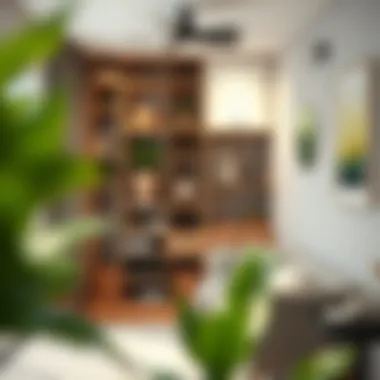
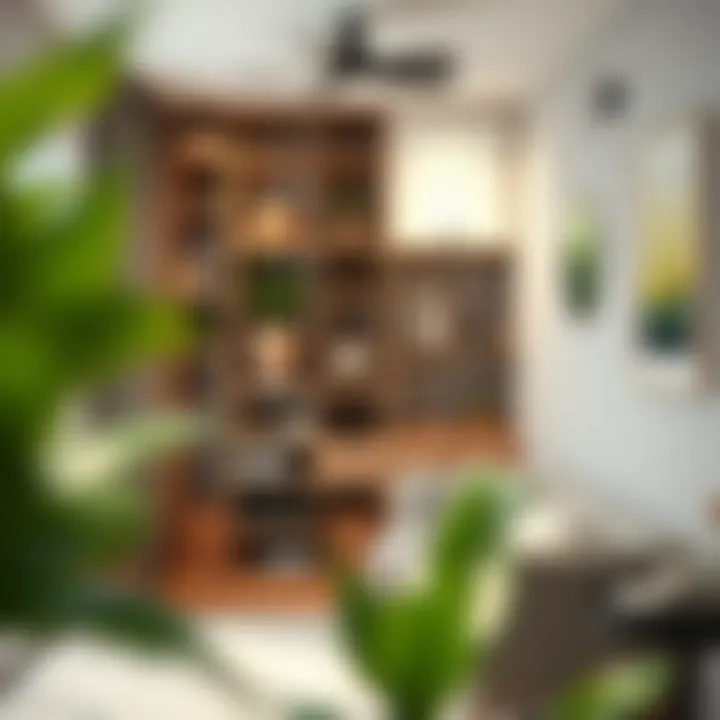
Here are a few emerging design principles that can be drawn from successful implementations:
- Functional Zones: Each section has a clear purpose, reducing clutter and confusion.
- Smart Furniture: Use furnishings that adapt to multiple needs, helping save precious floor space.
- Natural Elements: Incorporation of plants can enhance the aesthetic while purifying indoor air.
Lessons Learned from Unique Spaces
The journey through case studies can yield valuable lessons that go beyond design, reflecting the challenges and solutions found in real-life studio living. One poignant example can come from small homes in Tokyo, where space is a luxury and innovation is a necessity. Here, residents often adopt a philosophy of "less is more," focusing on quality over quantity. This leads to a lifestyle characterized by a clear purpose in belongings and furnishings, promoting minimalism as a means of enhancing day-to-day tranquility.
Moreover, knowing how to deal with privacy can make a significant difference in living comfortably in a studio apartment. Many successful designs advocate the use of curtains or screens to provide some degree of separation. This design consideration plays a crucial role in transforming the studio environment from a communal space into a more personalized retreat, making it truly feel like home.
"A well-designed studio is a balance of comfort and functionality; it’s where creativity meets practical living."
The takeaway is that every studio apartment can be unique, echoing the personality of its dweller. To achieve this, here are some key pointers from various success stories:
- Embrace Niche Ideas: Experiment with unconventional layouts or decor that reflect personal style.
- Prioritize Storage: Seek out hidden storage solutions to manage clutter effectively.
- Stay Adaptive: Allow space to change with needs, especially in multi-functional areas.
For additional insights on design elements that can transform small spaces, sites like ArchDaily and Apartment Therapy can provide noteworthy inspiration.
Delving into these case studies, it becomes clear that studio living is about more than just fitting a bed and a sofa into one room. It is an opportunity to craft a lifestyle that is both functional and stylish, using the limited canvas of a single room to express individual taste and needs. This ongoing exploration of successful studio apartments not only enhances our understanding of design but also brings to light the ever-changing dynamics of urban living.
Challenges of Living in a Studio Apartment
Living in a studio apartment can be an adventure filled with both perks and hurdles. Understanding the challenges allows you to approach this unique lifestyle with the right mindset, ensuring you make the most of your space and experience. When diving into the nuances of studio living, it’s crucial to acknowledge the challenges. This not only sheds light on the practical aspects but also invites a deeper reflection on how to innovate and personalize your small living space.
Privacy Concerns
In a studio apartment, privacy can seem like a luxury that's hard to come by. With everything packed into one room, the boundaries between living areas, kitchen, and bedroom blur into one another. This can lead to feelings of exposure, especially if you share the space with another person or even pets that crave their own quarters.
Nevertheless, there are creative ways to tackle privacy issues without resorting to cumbersome walls. Consider using tall bookshelves or open shelving units as room dividers. These not only serve as functional storage but create a visual barrier that offers a semblance of privacy.
Lightweight curtains that can be drawn to separate spaces can also do wonders. Imagine sipping a morning cup of coffee while your personal nook feels cocooned from the rest of your studio. Another tip is to invest in origami screens or folding partitions. They can be conveniently adjusted as needed, providing versatility when you wish to host guests or need some time alone.
Limited Space and Clutter
Limited space is, without a doubt, a defining characteristic of studio apartments. A common pitfall many face is the gradual accumulation of clutter, which can quickly turn a cozy haven into a chaotic mess. Keeping a tidy space is essential not just for aesthetics but also for your mental well-being.
To combat clutter, embrace minimalism and intentionality. Start by evaluating what you own; does that quirky lamp you bought at a yard sale still spark joy, or is it just gathering dust? Opt for multi-functional furniture like an ottoman that doubles as a storage unit or a bed with drawers underneath. It’s all about making every inch count.
Here are a few strategies to keep your space organized and reduce clutter:
- Regular Decluttering: Set a specific day each month to reassess your belongings and part with items you no longer need.
- Vertical Solutions: Install shelves up high for books and decor; they draw the eye upwards which can create the illusion of a larger space.
- Smart Storage Solutions: Use under-bed storage bins or utilize wall-mounted hooks for items like bags or accessories.
"Space is the breath of art." – Frank Lloyd Wright
Keeping your studio apartment organized and free of clutter improves not only the aesthetic but also allows you to enjoy your living environment to its fullest. Remember, the fewer possessions you have, the more room there is to enjoy the qualities of your studio to its fullest.
The Future of Studio Apartments
As urban landscapes evolve, one room studio apartments are becoming more than just compact living spaces; they symbolize a shift towards efficient and functional homes. The increasing population in cities means that space is becoming a luxury that many cannot afford. Studio apartments provide a practical alternative, allowing individuals to maximize living areas without breaking the bank. Understanding the future of these unique spaces is crucial as they mirror broader urban living trends and implications for residents.
Emerging Trends in Urban Living
Current trends show a notable shift in how people perceive living space. Urbanization is not just a temporary phase; it’s becoming the norm. Folks are increasingly gravitating towards smaller footprints, making studio apartments more desirable. Consider the following trends:
- Co-living Arrangements: These setups are sprouting up across cities. Young professionals often opt for collective living experiences that include shared amenities while maintaining their private space within studio apartments.
- Micro-living Developments: Projects featuring ultra-compact homes are also on the rise. These designs prioritize sustainability and efficient use of limited space, integrating innovative solutions for storage and functionality.
- Walkable Communities: Urban dwellers are increasingly valuing neighborhoods where daily necessities are within walking distance. This preference for accessibility drives demand for studio apartments located at the heart of lively urban areas.
As a result, the future of studio apartments will likely reflect an emphasis on sustainable living, community engagement, and convenience.
Technological Innovations
Advancements in technology are reshaping how we interact with our living spaces, particularly in studio apartments. Modern technology is not just about fancy gadgets; it also plays a significant role in simplifying life in small spaces. Some key innovations include:
- Smart Home Integration: More studios are being outfitted with smart devices that control lighting, temperature, and security. This allows residents to manage their environment efficiently, enhancing comfort even in compact spaces.
- Space-saving Solutions: Innovations such as foldable furniture, convertible beds, and modular storage options are gaining traction. These options allow inhabitants to reconfigure their spaces effortlessly, promoting multifunctionality.
- Virtual Reality and Augmented Reality: These tools are emerging as invaluable assistants in the design process. They enable potential renters to visualize spaces before committing, revolutionizing how people find and curate their living environments.
The future of studio apartments hinges not just on their physical layout, but on how technology can enrich the living experience.
End
Living in a one room studio apartment is not just a choice; it's a lifestyle decision wrapped in comfort, creativity, and sometimes a bit of compromise. In this article, we explored various intricacies of studio apartments, dissecting their unique charm while addressing the challenges they present. Each section has illuminated different aspects that make studio apartments a thrilling yet complex environment to inhabit.
Summarizing Key Insights
- Space Efficiency: One of the most significant insights is the efficiency of space. Studio apartments inherently encourage residents to think critically about their belongings. Choices regarding furniture and decor become vital, turning space into a canvas where every square foot counts. The trend of multi-functional furniture, like a couch that transforms into a bed, is not just a gimmick, it’s an astute approach to living.
- Zoning Techniques: Using zoning techniques emerges as another key takeaway. By creatively utilizing rugs, lighting, or furniture arrangement, it’s possible to create distinct spaces for functionality without imposing solid boundaries. This illusion of separation can enhance not only aesthetic appeal but also provide a sense of privacy.
- Storage Solutions: The importance of maximizing storage can't be overstated. Utilizing every nook and cranny is not only practical but has become an art form. Wall-mounted shelves and under-bed storage can transform clutter into curated collections. The idea is to be strategic, ensuring that what you choose to keep adds value to your living experience.
- Aesthetic Considerations: Color and lighting play a crucial role. Lighter color palettes can make a petite space feel more open and airy, while smart lighting choices can curate ambiance, determining the mood of the environment.
Final Thoughts on Studio Apartment Living
As urban spaces become denser and living costs rise, studio apartments are finding their footing as not just transient dwellings, but as balanced choices for many. Needing to adopt a conscious consumption strategy, residents develop a deeper appreciation for what they have. Living in a confined space fosters connections, whether with the environment or with nearby community hubs, making it less about space and more about the experience.
As we move forward, the dialogue on studio living should evolve to embrace sustainability and innovation. Elements like technology integration, such as smart home devices, will likely redefine how every inch of space can be used. Different cultural perspectives offer new viewpoints on communal living, redefining privacy and comfort in smaller residential designs. Overall, studio living is not simply an aesthetic choice; it's a lifestyle path that promotes creativity, simplicity, and adaptability in an ever-changing world.
"The solution to a lack of space isn't about building more room; it’s about creating a more meaningful space with what you have."
For deeper insights regarding design strategies and smart living, check resources like Wikipedia for broader context, or join discussions on platforms like Reddit for real-life experiences and trends.



